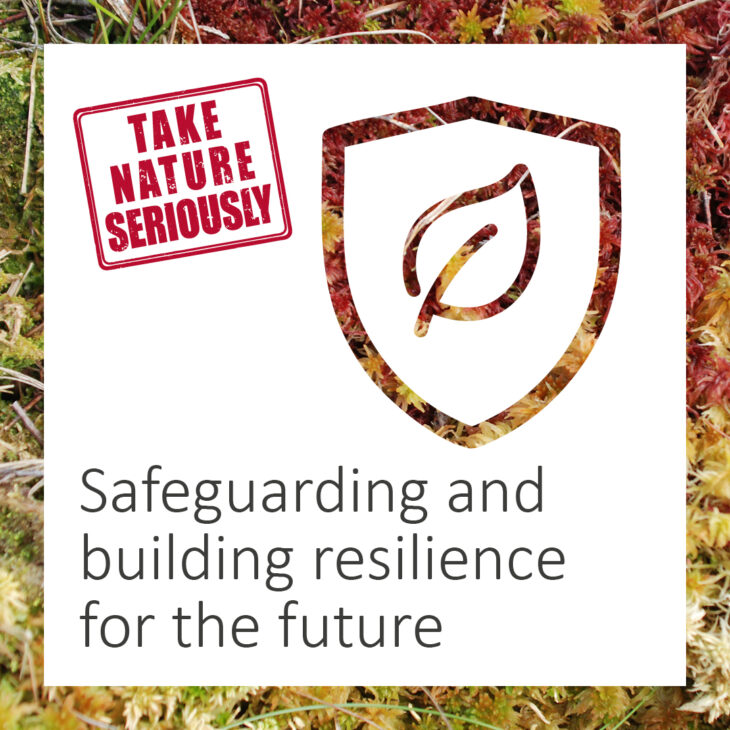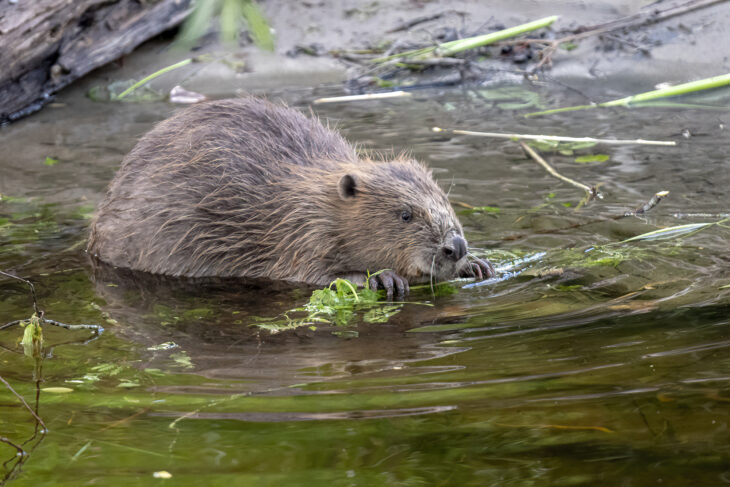Take Nature Seriously: Nature is integral to delivering long-term resilience
We urge Scotland’s political parties to Take Nature Seriously and commit to three core principles that will ensure nature is valued, protected and restored – all while Scotland moves towards a more resilient and prosperous future:
| Safeguarding and building resilience for the future – Protect and restore Scotland’s natural environment to secure a resilient, healthier future for all. | |
| Prioritising nature – Embed nature at the heart of policy as a cost-effective solution to public and environmental challenges. | |
| Securing investment and funding – Invest in nature with meaningful funding to reflect its true value and deliver lasting benefits. |
Below we explore the first of these core principles – the need to safeguard and build resilience for the future.

Safeguarding and building resilience for the future
Scotland needs policies that strengthen our resilience, support better physical and mental health, combat climate change, increase food security, create sustainable long-term jobs and provide and protect public services. Only nature can help to address all of these needs. By investing in nature now, we can deliver effective and affordable benefits for communities across Scotland for generations to come.
Given the importance of nature for society and the economy, it is the responsibility of political parties and those running for office to understand this relationship and the importance of a healthy natural environment for delivering a range of policy. Ultimately, there is no meaningful delivery on climate change without nature; public services like clean water and flood prevention cannot be delivered without nature; and “green-collar” jobs cannot be delivered without nature.
Failing to get a proper handle on ecological problems will seriously undermine our resilience and will ultimately cost the taxpayer more money in the long run. Invasive non-native species, such as the grey squirrel, threaten native wildlife and undermine vital reforestation efforts; and invasive non-native plants like Himalayan balsam destabilise riverbanks, increasing the risk of flooding in our communities. Meanwhile, neglecting the protection of sensitive seabed habitats such as seagrass can have wide ranging impacts. From reduced resilience to coastal flooding to the loss of important nursery grounds for fish stocks, this jeopardises our long-term ability to harvest this natural resource sustainably.
These are not distant threats – they are real and immediate risks to our economy, environment, and wellbeing. Tackling them head-on is essential if we are to build a Scotland that is prepared for the future.
It’s not just environmental organisations advocating for this way of thinking; Scottish Water are taking this seriously as well. Grant Vanson, who heads up work on nature-based approaches, recently said:
“By reducing the amount of rainwater that enters the sewer system we can reduce the frequency and severity of flooding from the sewer network. Our traditional drainage systems are not designed to cope with such volumes, so we must look at a more sustainable and holistic approach to managing rainwater. Scotland is facing increasing challenges from extreme weather events and climate change. We’ve all noticed the increase in the number of storms, rainfall, and flooding events”.
Building resilience through targeted nature policy:
- Prioritise support for river woodland restoration initiatives, particularly in agriculture and forestry policy and funding. This will deliver multiple “low hanging fruit” nature-based solutions like cleaning water and support the ever-increasing need for climate adaptation.
-
- The Trust calls for at least half of Forestry Grants to go towards supporting restoration of native woodlands (such as Scots pine, oak, and aspen) with riparian prioritisation applied.
-
- Co-operative “at scale” schemes need to be developed in Tier 3 of the reformed agricultural funding system, and crucially these schemes need appropriate budget.
- Fully embrace the role of beavers in delivering climate resilience through flood and drought mitigation by making it easier to move beavers to high-conservation value, low-conflict sites within Scotland (read more on the importance of beavers here).
- Reduce deer densities to sustainable levels to encourage woodland regeneration. NatureScot need to be empowered to deploy their full range of statutory powers, and prioritisation needs to be given to protected areas and the six landscape recovery zones identified by NatureScot. Within the six priority zones, emphasis should be placed on developing and fostering community led approaches, building skills, providing food and allowing people to take ownership of solutions to the climate and nature crisis (read more on our policy on deer here).
- Commit to ambitious action to tackle invasive non-native species, for example, Government-led strategic action to stop grey squirrels moving into the highlands and supporting a programme to remove and prevent invasive non-native conifers on peatland to support carbon sequestration.
- Implement adequate monitoring and enforcement of fisheries management measures to safeguard nature, as well as meaningful engagement with communities to ensure local support once the long-delayed measures are implemented for the marine protected area network (read more about marine protected areas here).
- Ensure the fishing fleet outwith the marine protected area network is operating sustainably through the use of Remote Electronic Monitoring, with adequate resourcing to analyse the data and enforce these measures being paramount (read more on our fisheries management policy here).

Beaver © Elliot McCandless
How you can get involved
Every voice counts in this election, and while it can feel overwhelming to sift through all the pre-election information, it’s incredibly important to have your say if you want things to change. This of course means voting in the elections next year, but it could also mean:
- Writing to current MSPs to urge them to prioritise nature
- Reading party manifestos when they’re launched
- Researching candidates and staying up to date (through party websites and other resources like Ballotbox)
- Attending campaign events and asking candidates where they stand on key environmental issues
- Raising awareness within your community about why this election matters for nature
To learn more about the many ways you can get involved with the Scottish Wildlife Trust please have a look on our website, and visit the Scottish Parliament and Electoral Commission websites to read more about engaging with the political process.
Whether you’re a seasoned activist or newly inspired to get involved, your voice can shape the future of Scotland’s political – and natural – environment.
Read our list of detailed policy asks here.

Header image © Euan MacDonald
Help protect Scotland’s wildlife
Our work to save Scotland’s wildlife is made possible thanks to the generosity of our members and supporters.
Join today from just £4 a month to help protect the species you love.
Preface
We urge Scotland’s political parties to Take Nature Seriously and commit to three core principles that will ensure nature is valued, protected and restored – all while Scotland moves towards …
